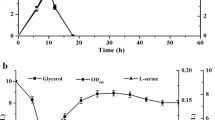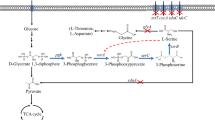Abstract
l-Serine is a nonessential amino acid, but plays a crucial role as a building block for cell growth. Currently, l-serine production is mainly dependent on enzymatic or cellular conversion. In this study, we constructed a recombinant Escherichia coli that can fermentatively produce l-serine from glucose. To accumulate l-serine, sdaA encoding the l-serine dehydratase, iclR encoding the isocitrate lyase regulator, and arcA encoding the aerobic respiration control protein were deleted in turn. In batch fermentation, the engineered E. coli strain YF-5 exhibited obvious l-serine accumulation but poor cell growth. To restore cell growth, aceB encoding the malate synthase was knocked out, and the engineered strain was then transformed with plasmid that overexpressed serA FR, serB, and serC genes. The resulting strain YF-7 produced 4.5 g/L l-serine in batch cultivation and 8.34 g/L l-serine in fed-batch cultivation.





Similar content being viewed by others
References
Jiang W, Xia B, Liu Z (2013) A serine hydroxymethyltransferase from marine bacterium Shewanella algae: Isolation, purification, characterization and l-serine production. Microbiol Res 168(8):477–484
Lai S, Zhang Y, Liu S, Liang Y, Shang X, Chai X, Wen T (2012) Metabolic engineering and flux analysis of Corynebacterium glutamicum for l-serine production. Sci China Life Sci 55(4):283–290
Remesy C, Fafournoux P, Demigne C (1983) Control of hepatic utilization of serine, glycine and threonine in fed and starved rats. J Nutr 113(1):28–39
Pizer LI, Potochny ML (1964) Nutritional and regulatory aspects of serine metabolism in Escherichia coli. J Bacteriol 88:611–619
Stolz M, Peters-Wendisch P, Etterich H, Gerharz T, Faurie R, Sahm H, Fersterra H, Eggeling L (2007) Reduced folate supply as a key to enhanced l-serine production by Corynebacterium glutamicum. Appl Environ Microbiol 73(3):750–755
Hsiao HY, Wei T (1986) Enzymatic production of l-serine with a feedback control system for formaldehyde addition. Biotechnol Bioeng 28(10):1510–1518
Izumi Y, Yoshida T, Miyazaki SS, Mitsunaga T, Ohshiro T, Shimao M, Miyata A, Tanabe T (1993) l-serine production by a methylotroph and its related enzymes. Appl Microbiol Biotechnol 39(4–5):427–432
Peters-Wendisch P, Stolz M, Etterich H, Kennerknecht N, Sahm H, Eggeling L (2005) Metabolic engineering of Corynebacterium glutamicum for l-serine production. Appl Environ Microbiol 71(11):7139–7144
Gu P, Yang F, Kang J, Wang Q, Qi Q (2012) One-step of tryptophan attenuator inactivation and promoter swapping to improve the production of l-tryptophan in Escherichia coli. Microb Cell Fact 11(1):30
Lee SY, Park JH (2010) Integration of systems biology with bioprocess engineering: l-threonine production by systems metabolic engineering of Escherichia coli. Adv Biochem Eng Biotechnol 120:1–19
Park JH, Kim TY, Lee KH, Lee SY (2011) Fed-batch culture of Escherichia coli for l-valine production based on in silico flux response analysis. Biotechnol Bioeng 108(4):934–946
Park JH, Lee KH, Kim TY, Lee SY (2007) Metabolic engineering of Escherichia coli for the production of l-valine based on transcriptome analysis and in silico gene knockout simulation. Proc Natl Acad Sci USA 104(19):7797–7802
Li Y, Chen GK, Tong XW, Zhang HT, Liu XG, Liu YH, Lu FP (2012) Construction of Escherichia coli strains producing l-serine from glucose. Biotechnol Lett 34(8):1525–1530
Peters-Wendisch P, Netzer R, Eggeling L, Sahm H (2002) 3-Phosphoglycerate dehydrogenase from Corynebacterium glutamicum: the C-terminal domain is not essential for activity but is required for inhibition by l-serine. Appl Microbiol Biotechnol 60(4):437–441
Datsenko KA, Wanner BL (2000) One-step inactivation of chromosomal genes in Escherichia coli K-12 using PCR products. Proc Natl Acad Sci USA 97(12):6640–6645
Li M, Gu P, Kang J, Wang Y, Wang Q, Qi Q (2012) Extending homologous sequence based on the single gene mutants by one-step PCR for efficient multiple gene knockouts. Folia Microbiol (Praha) 57(3):209–214
Martinez A, Grabar TB, Shanmugam KT, Yomano LP, York SW, Ingram LO (2007) Low salt medium for lactate and ethanol production by recombinant Escherichia coli B. Biotechnol Lett 29(3):397–404
Aboulwafa M, Hvorup R, Saier MH Jr (2004) Dependency of sugar transport and phosphorylation by the phosphoenolpyruvate-dependent phosphotransferase system on membranous phosphatidylethanolamine in Escherichia coli: studies with a pssA mutant lacking phosphatidylserine synthase. Arch Microbiol 181(1):26–34
Ikeda M (2006) Towards bacterial strains overproducing l-tryptophan and other aromatics by metabolic engineering. Appl Microbiol Biotechnol 69(6):615–626
Lorenz E, Stauffer GV (1996) MetR-mediated repression of the glyA gene in Escherichia coli. FEMS Microbiol Lett 144(2–3):229–233
Netzer R, Peters-Wendisch P, Eggeling L, Sahm H (2004) Cometabolism of a nongrowth substrate: l-serine utilization by Corynebacterium glutamicum. Appl Environ Microbiol 70(12):7148–7155
Waegeman H, Beauprez J, Moens H, Maertens J, De Mey M, Foulquié-Moreno M, Heijnen J, Charlier D, Soetaert W (2011) Effect of iclR and arcA knockouts on biomass formation and metabolic fluxes in Escherichia coli K12 and its implications on understanding the metabolism of Escherichia coli BL21 (DE3). BMC Microbiol 11(1):70
Wendisch VF, Bott M, Eikmanns BJ (2006) Metabolic engineering of Escherichia coli and Corynebacterium glutamicum for biotechnological production of organic acids and amino acids. Curr Opin Microbiol 9(3):268–274
Yamamoto K, Ishihama A (2003) Two different modes of transcription repression of the Escherichia coli acetate operon by IclR. Mol Microbiol 47(1):183–194
Alexeeva S, Hellingwerf KJ, Teixeira de Mattos MJ (2003) Requirement of ArcA for redox regulation in Escherichia coli under microaerobic but not anaerobic or aerobic conditions. J Bacteriol 185(1):204–209
Malpica R, Franco B, Rodriguez C, Kwon O, Georgellis D (2004) Identification of a quinone-sensitive redox switch in the ArcB sensor kinase. Proc Natl Acad Sci USA 101(36):13318–13323
Ornston LN, Ornston MK (1969) Regulation of glyoxylate metabolism in Escherichia coli K-12. J Bacteriol 98(3):1098–1108
Zhao G, Winkler ME (1996) A novel alpha-ketoglutarate reductase activity of the serA-encoded 3-phosphoglycerate dehydrogenase of Escherichia coli K-12 and its possible implications for human 2-hydroxyglutaric aciduria. J Bacteriol 178(1):232–239
Kang Z, Gao C, Wang Q, Liu H, Qi Q (2010) A novel strategy for succinate and polyhydroxybutyrate co-production in Escherichia coli. Bioresour Technol 101(19):7675–7678
Kovach ME, Elzer PH, Hill DS, Robertson GT, Farris MA, Roop RM 2nd, Peterson KM (1995) Four new derivatives of the broad-host-range cloning vector pBBR1MCS, carrying different antibiotic-resistance cassettes. Gene 166(1):175–176
Cherepanov PP, Wackernagel W (1995) Gene disruption in Escherichia coli: TcR and KmR cassettes with the option of Flp-catalyzed excision of the antibiotic-resistance determinant. Gene 158(1):9–14
Acknowledgments
This work was financially supported by a Grant from the National Natural Science Foundation of China (31370085), a Grant from National High-Tech Research and Development Plan of China (2012AA022104).
Author information
Authors and Affiliations
Corresponding author
Additional information
P. Gu and F. Yang contributed equally to this work.
Rights and permissions
About this article
Cite this article
Gu, P., Yang, F., Su, T. et al. Construction of an l-serine producing Escherichia coli via metabolic engineering. J Ind Microbiol Biotechnol 41, 1443–1450 (2014). https://doi.org/10.1007/s10295-014-1476-6
Received:
Accepted:
Published:
Issue Date:
DOI: https://doi.org/10.1007/s10295-014-1476-6




